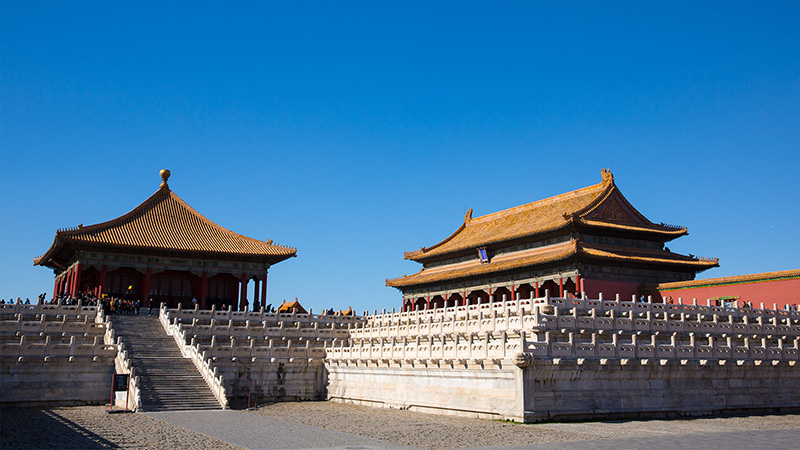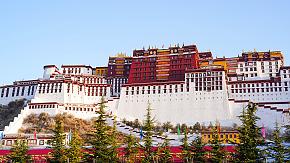The Complete Travel Guide of Forbidden City
The marvelous Forbidden City, also known as the Imperial Palace, was listed by UNESCO as one of the World Cultural Heritage sites in 1987. Carrying the experiences of two dynasties of Ming and Qing, nowadays the largest museum in China (Beijing Palace Museum), with about 9,000 rooms in total and millions of collections. If you're planning a trip to China and are interested in its profound history, then the Forbidden City is on your must-see attractions list!
 Overlook the Forbidden City from Jingshan Park
Overlook the Forbidden City from Jingshan Park
Why is It Called the Forbidden City
It is a general saying from regular folks. Serving as the workplace and home for emperors, this ancient palace is strictly guarded and forbids ordinary people from unnecessarily entering. That's why this imperial palace is also called the "Forbidden City".
Brief Intro to the Forbidden City Palace
- Alternative name: Palace Museum, Gugong
- Built: 1406 to 1420 during the Ming Dynasty
- Size: About 180 acres / 720,000 m² (roughly 96 American football fields)
- Buildings: Around 980 structures, 17 palaces, and more than 8800 rooms
- Layout: Perfectly symmetrical along Beijing's north-south axis
- Opening Hours:
More Facts About the Forbidden Palace
- The grand imperial palace that once housed 24 emperors from the Ming and Qing dynasties. It served as China's royal residence for nearly 500 years.
- The length and width of the Forbidden City are 961 and 753m, which is surrounded by a 52m moat and protected by 10m ramparts.
- This palace was divided into two parts(the outer and inner courts) according to the layout and function.
- The six halls on the central axis of the complex are the most popular and visited.
More Attractions around Forbidden City
 More Attractions Around Forbidden City
More Attractions Around Forbidden City
Recommended Forbidden Sightseeing Routes & Map
Classic Route along the Axis
 Recommended Forbidden City Sightseeing Route in 2 Hours
Recommended Forbidden City Sightseeing Route in 2 Hours
Half Day Route With East Palaces
 Recommended Forbidden City Sightseeing Route in Half Day
Recommended Forbidden City Sightseeing Route in Half Day
One Day Round Route
 Recommended Forbidden City Sightseeing Route in One Day
Recommended Forbidden City Sightseeing Route in One Day
When to Visit the Forbidden City Museum
The best time to visit the Forbidden City is between spring (April to early June) and autumn (September to October), the golden travel time of China when the sky is clear and blue, temperatures are mild (10 to 22℃, 50 to 72℉), and most importantly, with relatively fewer domestic tour groups.
Note:
- Arrive early to avoid the massive mid-morning rush around 10 AM. Gates open around 8:30 AM, but people start lining up before 8.
- Late afternoon (after 3 PM) is also calmer, especially near the north gate and side halls, though note the palace closes by 4:30 PM in winter / 5 PM in summer.
- Plan at least 2 to 3 hours, ideally half a day if you want to see beyond the main axis.
When to Avoid
- Summer (July to August): Hot, humid (30℃, 86℉), and crowded with local tour groups and school trips. Prepare sufficient water, sunscreen, and patience well, and you will still enjoy your journey.
- Major Holidays: Chinese New Year (Jan/Feb), May 1 to 5 (Labor Day), and October 1 to 7 (National Day Golden Week). Crowds can be overwhelming, and ticket availability is tight.
Forbidden City Tickets Booking
The fact is that there are no on-site ticket sales for the Forbidden City. The Palace Museum requires all visitors, including foreign visitors, to book tickets online in advance, often requiring a local phone number and WeChat or Alipay payment method.
You may encounter a payment failure since foreign credit cards are not always accepted, and tickets for popular dates often sell out within hours after release. If so, let Odynovo be your reliable tour operator for help.
Planning a custom private China tour with us to take care of all those details, from securing your Forbidden City entry in advance to designing a smooth, crowd-free day in Beijing tailored entirely to your pace and interests.
What You Can See Inside the Forbidden City
Outer Three Halls
Enter from the Meridian Gate, passing the golden water bridge and through the peaceful gate, you will see one of the outer three halls - the Hall of Supreme Harmony.
It is the largest hall in the palace, which is 2377 square meters in total. The interior also has a luxury decor, with golden brick paving its ground, and a dragon stays in the sunken panel. In the past, emperors held grand ceremonies in the Hall of Supreme Harmony, such as the emperor's inauguration, wedding, and choosing a general to fight wars.
The hall behind the palace is the Hall of Central Harmony and the Hall of Preserving Harmony. Those two halls have a similar design but serve different functions for emperors resting and changing clothes.
Inner Three Court
The three inner palaces are the Palace of Heavenly Purity, the Hall of Union, and Earthly Tranquility. When you go through the door and connect to the inner court, the first building shown in front of you is the palace of heavenly purity.
As the bedroom of Ming Dynasty emperors, it is designed into two floors with nine rooms for concubines to sleep and also for the emperor's security, since it is hard for assassins to figure out where the emperor stays.
And queens in the past lived in the Palace of Earthly Tranquility behind it. They are surrounded by the Western Six Palaces and Eastern Six Palaces, where live concubines of emperors.
 Forbidden City
Forbidden City
The Imperial Garden
Continue walking along the axis and through the Earthly Tranquility Gate, and you will come into the Imperial Garden, where busy emperors enjoy their leisure time, and also their families.
Inside, there are some ancient trees whose age is over 100 years, strange stones in various shapes, and elegant pavilions in different kinds of styles, as one of them is famous for pots of precious begonia with blood-like red during its flourishing time.
Whenever you go, this place is always valuable for viewing. The passages are paved with colorful cobbles to form over 900 pictures of people, flowers, natural scenes, Beijing opera characters, and legendary stories.
Various Galleries
If you would visit these galleries, here are some route recommendations: The Treasure Gallery - The Gallery of Clocks - The Sculpture Gallery - The Furniture Gallery - Gallery of Painting and Calligraphy.
- The Gallery of Clocks (at the Hall for Ancestral Worship): With 5 parts to exhibit distinguished clocks from various periods and nations to show the development of clocks.
- The Furniture Gallery (at South Storehouses): Displays furniture made in the Qing Dynasty, which is arranged in different functional areas, such as study rooms and courtyards, to serve various purposes.
- The Sculpture Gallery (at Palace of Benevolent Tranquility): In this gallery, you will see vivid sculptures from different regions in China, including the world-renowned Terracotta Warriors from Xi'an and the white stone Buddhist statues from Hebei Province.
- The Treasure Gallery (at The Palace of Tranquil Longevity): There are exquisite items made of precious materials, such as jade, jadeite, gold, silver, pearls, and other precious and semi-precious stones, to be displayed in 6 units.
- The Bronze Gallery (at The Palace of Celestial Favor): Collects more than 15,000 pieces of bronze artefacts. And only 1,600 collections of them have inscriptions from the pre-Qin dynasty (the first dynasty in Chinese history).
- Gallery of Painting and Calligraphy (at The Hall of Literary Brilliance): Highlighted Chinese calligraphy (Seal script, clerical script, cursive script, regular script, and semi-cursive script) and painting (landscape painting and flower-and-plant painting).
 Shoukang Palace-Palace of Longevity and Good Health
Shoukang Palace-Palace of Longevity and Good Health
Forbidden City Photography Tips
When the museum is near its closing time, the light of dusk is giving good texture, also it will the number of visitors will gradually reduce. For these two reasons, it is a good opportunity to shoot majestic halls as if in that period.
If you are pursuing powerful images, have a look at these places: the bridge and the steps in front of the Concorde, where to can hold the mobile phone in a high position to shoot the big scene, and then at the Yong Alley, which is a narrow passage between two red walls. it appears in many media works, and here it has become one of the popular places for taking photos.
Let your photographer hold you in a lower position and capture you standing in this seemingly endless passage; it creates a gentle, sad feeling.
It doesn't always stick to the axis. Go to both sides of the palace museum, because there are fewer people. Remember to capture in different positions; otherwise, other visitors appearing in your shot will break your photo's structure and make it less attractive.
Buildings such as the Palace Museum are more suitable for a square front angle, because they show an aesthetic sense of symmetry.
 Dusk Light of Forbidden City
Dusk Light of Forbidden City
Forbidden City Restaurants
As the Forbidden City is a large resort, there are some food stations set in there for visitors to replenish energy. Ice Cellar Restaurant, which is near the Hall of Benevolent Peace, is a place for ice cream and simple cuisine. The Palace Museum Restaurant is next to the Palace of Earthly Tranquility, providing Chinese fast food. And Wan Chun Jinfu Low Tea, next to the Palace of Earthly Tranquility, serves Chinese tea.
Discover the Forbidden City With Odynovo
Nowadays, with numerous visitors entering this mysterious palace, which belonged exclusively to emperors. All of the secrets and memories of it are gradually revealed to people. Every piece of brick, each wisp of wind, every piece of tile, and every single tree here is there to tell their profound stories. It is a meaningful place for everyone to broaden horizons. Even if you are not a native, the Forbidden City will satisfy all of your imaginations for China and leave a great impression on your mind!
Related Posts You May Like
What Our Clients Say
Explore the latest verified reviews of Odynovo's travel services on Tripadvisor, Google, Trustpilot, Product Review and more trusted platforms.













